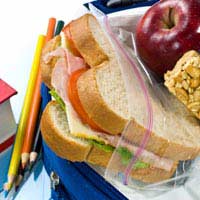Which is Better: School Meal or Packed Lunch?

According to the School Food Trust and the Local Authority Caterers Association (LACA), in the school year 2009-10, take-up of healthy school meals increased in primary and secondary schools to around 321,000. The proportion eating school lunches is 41.4% in primary schools and 35.8% in secondary schools.
Advantages of School Meals
Listed below are some of the advantages of schools meals:Variety and Choice
These days, school menus offer a choice, rather than everybody eating the same thing, which makes eating more interesting, helps fussy eaters because there is likely to be something that they like, and teaches children independence and decision-making. Some schools issue menus at the beginning of the week, or even have them on the school website.School lunches can also give the children the opportunity to try new foods that they don’t get at home, and to try food from other cultures. Eating school dinners can offer more variety than having the same sandwiches every day.
Convenience and Time and Money Saving
It can take a lot of time to think about different menu ideas to avoid packed lunches getting boring, and to shop for and prepare the packed lunches every day. School lunches are convenient and save parents time, and can often save money too.Some schools have a ‘grab and go’ option, allowing children who have lunchtime clubs the chance to get something healthy to eat.
Wellness
In 2005, a study showed that children who had school lunches had lower cholesterol levels, lower blood sugar and lower levels of insulin, as well as lower levels of leptin, which indicates the degree of ‘fatness’.Not all schools have fridge space to store packed lunches, and so on hot summer days, packed lunches may become unhealthily warm.
Healthy Eating
Some parents have a perception that school lunches are unhealthy and packed lunches are healthy, because they can control the contents. Following efforts by campaigners such as Jamie Oliver and the School Food Trust, school lunches have become higher quality, more nutritious, more tempting and more attractive. They use many more fresh ingredients than they used to, and are significantly healthier than high fat, high salt and high sugar packed lunches containing sweetened fizzy drinks, crisps and chocolate – all things that have been banned from school canteens.Well-balanced school meals can teach children about healthy eating and create habits that they can carry on into the rests of their lives. They also provide a healthy, nutritious and well-balanced meal – for some children, this may be the only one they get in a day. Some schools also provide breakfast – many children do not get breakfast, and this can affect their behaviour and ability to learn.

Re: Superfoods on a Budget
I just checked out these fantastic tips for buying superfoods on a budget! Eating healthy doesn’t have to be expensive. Can’t wait to try…
Re: Fun Facts: How Many Calories Does a Child Burn?
hi, im eleven yrs. I weigh about 100 lbs and believe I am over the normal weight. I am about 4’10 ft. I…
Re: Fun Facts: How Many Calories Does a Child Burn?
I want to clear this up for everybody worried about their weight, especially at a young age you shouldn’t…
Re: Dealing with a Child that is Always Hungry
I am the great grandmother of an 8 year old that I mostly take care of her mom is around but she totally depends…
Re: Fun Facts: How Many Calories Does a Child Burn?
I’m 11 years old and recently got a smart watch. This isn’t a big question but I can’t find how many…
Re: Dealing with a Child that is Always Hungry
I'm immediately suspicious of an article that suggests cereal as a healthy snack. Cereal (especially cereal…
Re: Fun Facts: How Many Calories Does a Child Burn?
How many calories SHOULD an average twelve year old burn daily???
Re: Fun Facts: How Many Calories Does a Child Burn?
I'm 9 years old and I'm trying to set up a health journal but I don't know how many calories I should…
Re: Fun Facts: How Many Calories Does a Child Burn?
Hiw much calories should an average 10 year old burn a day?
Re: Dealing with a Child that is Always Hungry
I’m 16 and my sister is 11 years old 57 inches and weighs 90 pounds she only drinks like 2 or 3 16 ounce bottles…